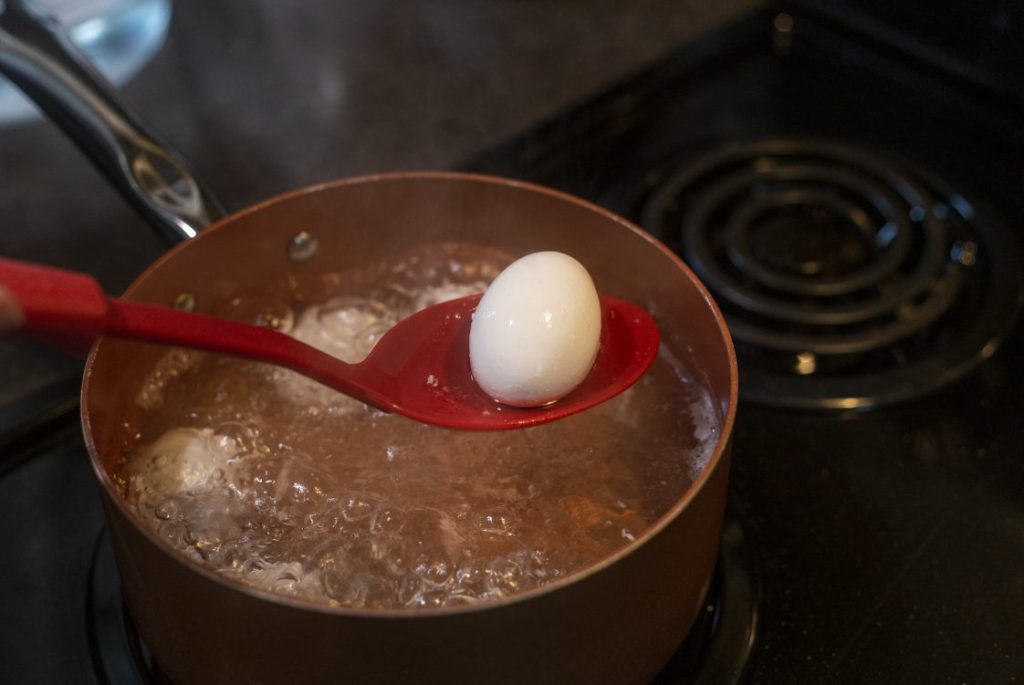Tips for enhancing egg quality and safety from washing to cooking
Published 5:56 pm Thursday, April 10, 2025

- Aces.edu
Whether you are a backyard producer or a consumer of eggs, quality and safety are important to protect yourself and your family from potential hazards, such as Salmonella. Proper packaging and safe cooking practices are critical to maintain the quality and safety of your eggs.
Egg Washing
In the United States, commercially produced eggs are washed, a process that removes the cuticle or bloom, a protective layer that helps prevent bacteria from entering the egg. In other parts of the world, eggs are not washed and are stored at room temperature. Whether eggs are washed or not, refrigeration is always the best practice to reduce the growth of bacteria and maintain egg quality. Before washing, eggs should have an internal temperature of at least 60°F. If they are cold, allow them to temper by leaving them at room temperature for a couple of hours. Always wash eggs with water that is at least 90°F and at least 20°F warmer than the egg’s internal temperature. When washing, never leave eggs submerged in water, as this can cause water and bacteria to be drawn into the egg through the shell pores, potentially leading to contamination.
The three main methods to clean eggs are mechanical, chemical, and enzymatic. These methods can be used individually or in combination, similar to commercial egg industry practices, where both mechanical and chemical cleaning are commonly employed.
Mechanical cleaning involves scrubbing or rubbing to remove dirt using a brush, sponge, or paper towel. If water is used, it is essential to ensure cleanliness by using flowing tap water or frequently changing water when dipping eggs. Dirty water is less effective for cleaning and can introduce contamination.
Enzymatic cleaners are typically liquid or foam-based products that use enzymes to break down organic material. Examples of enzymes include proteases, lipases, amylases, and cellulases, which are derived from natural sources. These enzymes can help break down bacteria, proteins, fats, and other soils on the eggshell surface. However, enzymes only clean organic materials and do not disinfect the eggshell. These products are often marketed as an alternative to the use of chemicals for washing eggs.
Carton Types
New cartons are typically clean, but the number of bacteria on the carton increases the longer it is stored with eggs (figure 3). After 7 days of storage, pulp cartons contained 1.3 times more bacteria than plastic cartons, and foam cartons had nearly 2 times more bacteria than plastic cartons. After 14 days of storage, pulp cartons had over 4 times more bacteria compared to plastic cartons, and foam cartons had over 3 times more bacteria. While the number of bacteria on plastic cartons did increase with the eggs’ storage, it remained relatively steady. In contrast, bacteria levels on both pulp and foam cartons increased over time. This is likely due to the material composition of the cartons. Plastic cartons have fewer openings for bacteria to attach, which is why bacterial counts remained low. Pulp and foam cartons, on the other hand, have more holes, making them more conducive to bacterial growth. For a backyard producer or consumer planning to reuse cartons, plastic would be the ideal choice. While pulp and foam cartons are usually less expensive, they tend to be less sturdy and more prone to harboring bacteria.
Egg Storage and Quality
Where to Store Eggs. Store your eggs in the refrigerator, but not every place inside the refrigerator is ideal. Always keep eggs in their carton rather than exposing them to the air inside your refrigerator. A carton not only protects the eggs during transportation, but it also prevents them from absorbing odors and helps reduce moisture loss. After all, no one wants their eggs to taste like onions. Do not store eggs in the refrigerator door. Instead, place them in the main compartment. This protects the eggs from potential cracks caused by the door opening and closing and prevents exposure to temperature fluctuations that occur when the door is frequently opened.
How Quality Changes. Eggshells have thousands of pores that help regulate gas exchange. Keeping eggs in their carton in the refrigerator slows down moisture loss and helps maintain quality for a longer period. Eggs stored at room temperature lose almost double the amount of moisture compared to those in the refrigerator during the same amount of time. A good rule of thumb is that storing eggs at room temperature for 1 day is equivalent to keeping them in the refrigerator for 1 week. As eggs age, egg whites become more watery. The thick albumen (egg whites) breaks down into thinner albumen, resulting in a more watery appearance. Egg yolks also become wider and flatter over time because the thick albumen that kept the yolk small and round breaks down into thin albumen. Also, the vitelline membrane surrounding the yolk weakens as eggs are stored. Egg pH increases as eggs age due to gas exchange. There is a faster increase of pH in eggs stored at room temperature compared to those stored in the refrigerator. Deterioration of egg quality has both positive and negative effects. For example, when making hard-boiled eggs, fresh eggs can be difficult to peel because the egg whites stick to the membrane inside the shell. As the pH of the egg white increases, the attachment lessens, making the shells easier to peel. On the other hand, fresh eggs are critical for good functionality during baking. Using fresh eggs will result in fluffier and more stable dishes. For example, egg whites from older eggs will form foam more quickly, but the foam is less stable, allowing trapped air to escape and result in a denser cake.
Information on the Carton
The best by or use by date is typically printed on the end of the egg carton. Eggs used before this date will have the best quality. If the eggs come from a commercial source, additional information can also be found on the carton, including the Julian date and plant number. The Julian date is a three-digit code that indicates when the eggs were packed. A code of 001 indicates that eggs were packed on January 1, while 365 indicates December 31 in a non-leap year and 366 for leap years. The plant number, which starts with a P identifies the facility where eggs were processed. This number is used for traceability in case of a recall. Figure 4 illustrates the end of an egg carton, highlighting the Julian date, plant number, and best by date.
Food Safety While Cooking Eggs
Eggs should be cooked until both the egg white and the yolk become firm. Dishes containing eggs should always be cooked to 160°F or 71°C to ensure that any harmful bacteria are destroyed. Cold dishes should be kept cold (below 45°F), and hot dishes should be kept hot (above 140°F). Dishes stored for extended periods of time in the danger zone (50°F to 139°F) for more than 2 hours should be discarded. The danger zone is the optimal growing range for most pathogenic bacteria. When preparing dishes with eggs, wash your hands before and after handling raw eggs and frequently throughout the preparation process.
How to Crack an Egg
On the side of a bowl or pan. Cracking eggs on the edge of a bowl is not a recommended method as it increases the likelihood of shell fragments entering your dish, possibly introducing bacteria to the bowl or pan. Also, egg white will often drip down the side of the bowl or pan, creating a mess.
On a flat surface. Cracking an egg on a flat surface, such as a plate or countertop, helps prevent shell membranes from rupturing, preventing egg contents from leaking onto the counter. To use this method, tap the egg firmly on the flat portion of the counter, then insert your fingers into the crack and pull the two shell halves apart.
With a butter knife. Using a butter knife is the ideal way to crack an egg. This method creates a clean crack with minimal shell breakage. With a swift motion, hit the egg in the equator with the back of a butter knife. Then, insert your fingers into the crack and gently pull the two shell halves apart.
Separating Eggs
Once you have cracked an egg, you may need to separate the yolk from the whites. Regardless of the method you choose, always separate eggs into a separate bowl before adding them to your mixing bowl. This prevents fats from the yolk accidentally mixing with the egg whites, which can reduce the functionality of the egg whites in your dish preparation. For example, when making a dish such as angel food cake, fats can inhibit the formation of the stiff foam peaks, resulting in a denser final product.
With eggshell. Separating eggs using the eggshell is not recommended due to the possibility of contaminating the egg contents with bacteria that are present on the shell. Also, there is a possibility that the cracking process could create sharp points causing the yolk to break.
With egg separator. The preferred method is to use an egg separator. Once the egg is cracked, the contents are placed into the separator where the yolk sits in a cup and the egg white drains through holes in the separator into a catch vessel below.
With hands. While separating eggs with your hands is not preferred, it is still a better option than using the eggshell. Always be sure to wash your hands before and after handling raw eggs.
Summary
Egg quality and safety are crucial for both producers and consumers. Proper handling of eggs, from packaging to cooking, are key in maintaining their freshness and reducing health risks. This overview emphasizes the importance of safe handling, proper cleaning methods, and optimal storage to maintain egg quality and minimize health risks.





